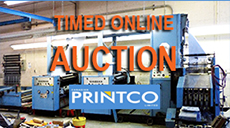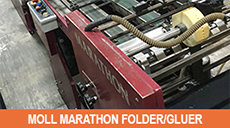A demonstrator that looks and acts irritable, mutters under his breath, is bad for everyone. This situation alone; not realizing it’s the buyer who counts, is a death knell.
As on the opening night of a big-budget theatrical presentation, if the demonstrator loses it then the entire house falls down quickly. But they are playing to an audience of one and dangerous comments start to flow like “this press can do it but the stock is a problem” and “I’m not sure why you specified this ink or etch.” Meanwhile, the buyer is getting annoyed, because the press will not print their purple or green without streaks, even if their current machine can – “Why would I buy this new press?”
Some manufacturers put on great shows and will be sure to have the machines running at top speed from the moment you walk into the demonstration room. They want your initial opinion to be positive. Other press makers will focus more on showing key features of the press, understanding, that as a veteran printer, the buyer already knows why modern presses run fast, change plates fast, and that rarely does that printer truly care about running all out. These manufacturers face a difficult challenge when a savvy printer walks into the demo room.
From the manufacturer’s point of view, however, demos are a necessary evil. Structurally speaking, today’s machinery, especially from the top press makers, is very good – solid, dependable, fast and ready to print the highest quality of work. But on any given demo day, human intervention can make the most modern machine have a bad day.
Over the years, I have seen many demos and the successful ones usually come about because the press maker fully understands what the buyer is after. When the press maker does not, and is more interested in showing off or pushing cutting-edge options, problems will usually arise. Almost always, these problems cannot be fixed.
Tried and true
Selling on the used-equipment market, our plant [Howard Graphic Equipment] reconditions presses by focusing on register and function, which are usually not significantly covered during the demonstration of a brand-new press.
To access press register, the common tool used by most is the GATF test form, now being developed by the Printing Industries of America organization, which allows measuring devices to analyze production issues like fit, register, dot gain, slurring or doubling. However, the GATF test form is somewhat of a mixed blessing because it is open to all kinds of interpretation. Yet, we use it to ensure the soundness and ability to print within an acceptable range.
After all, used machinery suppliers have a very different outlook with demos than do new-press suppliers. With used press demonstrations, the buyer is not coming to decide on a particular brand of press but rather a specific press. If all functions work, the press registers and fulfills an internal pass of the GATF test form, then we as an industry want and expect you to be pleased. That’s precisely where we too get ourselves in trouble, if the buyer again has expectations that do not meet with reality. No one sells GATF sheets. Internally, we know what we have in a press just by running it, but sometimes we do not understand why a printer still wants to see his job demonstrated on that machine.
If press technicians were press buyers, it would be easy to have great demos because technicians truly appreciate what makes a press suitable for a particular company. They can easily filter out manufacturer hype and drill down the core of a printing company’s needs. Technicians and demonstrators know their machinery is great and that most so-called difficult tests, although seemingly reflective of that specific press, can be traced to secondary areas of print production. But technicians do not buy presses, nor do demonstrators or salespeople. Printers buy presses.
I remember talking to a salesperson back in 2002, when he was close to selling a press to a very large packaging company in North Carolina. He lost the deal. As any good salesman does, he called the printer to ask why. The press demonstration had gone reasonably well, and the price was certainly in-line with market value. So, why had he lost the sale – it came down to a beauty contest. The printer told the salesman that the other press was just so darn nice-looking.
Can simple aesthetics make the difference between two million-dollar machines? In this case it did, as both presses were of equal high quality and features. Buying decisions are complex. Losing a sale for such a silly reason drives manufacturers nuts, which is why many will spend too much time on the superficial aspects of their machines. Big, flat screens, fancy cabinetry, it all adds up to leveraging the buyer’s perception of their equipment.
Talk to most manufacturers and the message is similar: Gone are a lot of the oldfashioned mechanical highlights of yesteryear. In essence, most printers take it as a given that modern, high-end machines are, for the most part, equal in capability. Most important of all is the functionality and “smartness” of the equipment. Paramount is the development of unique software for reducing waste and manpower. On a good day, this is exactly what the demo room will convey by showing the printer specific tools and options that fit their business model to a tee – printing is arguably the most unique form of manufacturing.
In reality, the environment in a demo room is not the best place to see the press running. A much better solution is at a user location, but manufacturers do not always encourage this approach because they cannot control the environment, or often showcase specific press features. For example, the demonstrating shop is likely to have established its own make-ready protocol, which may take a few extra minutes. In fact, the shop’s workflow might engage the buyer enough to think differently about what they need in a machine.
Maybe the demonstrating shop and machine look like a horror show, even if they work well in concert. Personally, I like going to an end-user and also to a demo room to get a full perspective on a machine’s capabilities – best-case scenarios combined with real-world scenarios. There is no better resource than getting a few minutes with an honest operator who is running your new potential press on a daily basis, through thick and thin.
At my company, we have lost sales during a demo, and it’s not fun to find out if a buyer purchases a press elsewhere – often buyers may not purchase a new press for several more months, even if they make it to the demo stage. When the demonstrator really learns to read a situation and the salesman has done their homework, however, good things happen for all parties involved, more often than not.
Getting all three players to read from same script is sometimes difficult, but absolutely necessary for a positive outcome. Great demos are only designed to titillate the buyer. There is much more that the buyer and seller can share, and it is best to communicate these needs well before anybody walks into a demonstration room.
|







